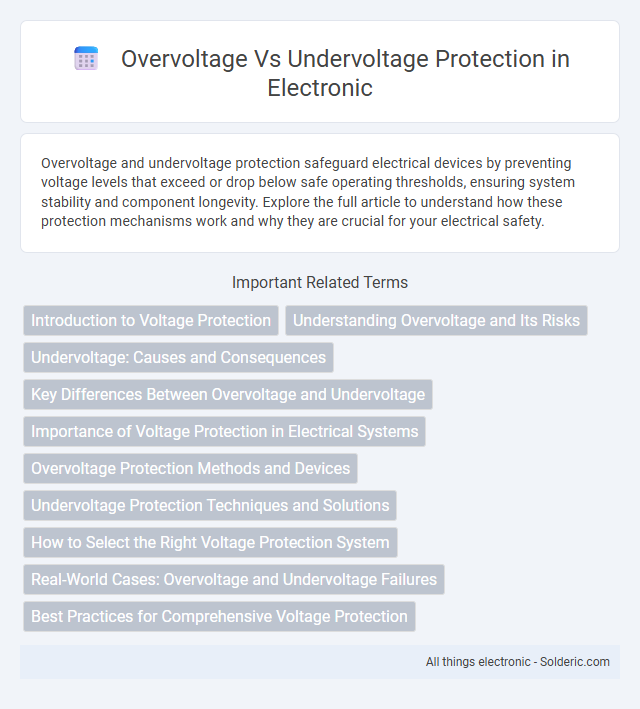Overvoltage and undervoltage protection safeguard electrical devices by preventing voltage levels that exceed or drop below safe operating thresholds, ensuring system stability and component longevity. Explore the full article to understand how these protection mechanisms work and why they are crucial for your electrical safety.
Comparison Table
| Feature | Overvoltage Protection | Undervoltage Protection |
|---|---|---|
| Definition | Prevents voltage levels exceeding the maximum limit. | Prevents voltage levels dropping below the minimum limit. |
| Purpose | Protects devices from damage caused by excessive voltage. | Avoids malfunction or shutdown due to insufficient voltage. |
| Common Devices | Surge protectors, voltage clamps, crowbars. | Undervoltage relays, voltage monitors, automatic restart controllers. |
| Typical Voltage Threshold | Above rated voltage, e.g., 110%-120% of nominal voltage. | Below rated voltage, e.g., 80%-90% of nominal voltage. |
| Effects Without Protection | Component damage, overheating, insulation breakdown. | Device malfunction, data loss, motor stalling. |
| Activation Method | Voltage sensor triggers disconnect or clamp. | Voltage sensor initiates shutdown or alarm. |
| Application Fields | Power supplies, industrial equipment, consumer electronics. | Battery-powered devices, motor drives, control systems. |
| Standards & Regulations | IEC 61000-4-5, IEEE C62.41. | IEC 60947-4-1, UL standards for undervoltage protection. |
Introduction to Voltage Protection
Voltage protection safeguards electrical systems by preventing damage caused by overvoltage and undervoltage conditions. Overvoltage protection limits excessive voltage surges that can harm devices, while undervoltage protection ensures stable operation by preventing voltage drops below critical thresholds. You can enhance equipment lifespan and maintain operational reliability by implementing both types of voltage protection in your systems.
Understanding Overvoltage and Its Risks
Overvoltage occurs when the electrical potential exceeds the normal operating voltage, leading to equipment damage, insulation breakdown, and possible system failure. Understanding the risks associated with overvoltage is critical for implementing protection devices such as surge protectors, voltage regulators, and circuit breakers that safeguard your electrical systems. Effective overvoltage protection ensures operational reliability and prevents costly repairs or downtime caused by voltage spikes.
Undervoltage: Causes and Consequences
Undervoltage occurs when the electrical supply voltage drops below the equipment's required operating level, caused by factors such as overloaded circuits, faulty wiring, or utility power fluctuations. This condition can lead to motor overheating, reduced efficiency, equipment malfunction, and potential damage to sensitive electronics. Implementing undervoltage protection safeguards your devices by automatically disconnecting power during low voltage events, preventing costly failures and ensuring operational reliability.
Key Differences Between Overvoltage and Undervoltage
Overvoltage protection safeguards electrical devices by preventing voltage from exceeding a set threshold, while undervoltage protection ensures voltage does not drop below a minimum level, maintaining device stability. Overvoltage conditions can cause insulation breakdown and equipment damage, whereas undervoltage often leads to reduced performance and motor stalling. Your systems benefit from both protections to enhance reliability and prevent costly failures.
Importance of Voltage Protection in Electrical Systems
Voltage protection in electrical systems is crucial for maintaining device longevity and preventing costly failures by guarding against both overvoltage and undervoltage conditions. Overvoltage protection prevents damage from voltage spikes and surges, while undervoltage protection ensures stable operation by preventing abnormal low voltage that can cause equipment malfunction. Ensuring your system includes reliable voltage protection safeguards performance, enhances safety, and minimizes downtime in critical applications.
Overvoltage Protection Methods and Devices
Overvoltage protection methods primarily include the use of surge protectors, voltage clamps, and metal-oxide varistors (MOVs) that safeguard electrical equipment by diverting or absorbing excess voltage spikes. Devices such as transient voltage suppressor (TVS) diodes and gas discharge tubes provide fast response times to transient overvoltage events, preventing damage to sensitive electronic components. Implementing these protection techniques ensures system reliability, minimizes downtime, and extends the lifespan of electrical installations.
Undervoltage Protection Techniques and Solutions
Undervoltage protection techniques safeguard electrical equipment by detecting voltage levels below a preset threshold and disconnecting the load to prevent damage or malfunction. Common solutions include undervoltage relays, voltage monitoring devices, and programmable logic controllers (PLCs) configured to trigger alarms or shutdowns during voltage sags. Your system's reliability improves significantly by integrating these solutions, ensuring stable operation despite voltage fluctuations.
How to Select the Right Voltage Protection System
Selecting the right voltage protection system requires analyzing the specific voltage tolerance range of your equipment and the typical fluctuations in your power supply. Overvoltage protection devices guard against voltage spikes that can damage sensitive electronics, while undervoltage protection prevents operation during dangerously low voltage conditions that may cause malfunction or damage. Your choice should be based on the critical voltage thresholds of your system and the environment's historical electrical disturbances to ensure optimal reliability and safety.
Real-World Cases: Overvoltage and Undervoltage Failures
Overvoltage can cause insulation breakdown and permanent damage to electronic components, leading to system failures in industrial machinery and household appliances. Undervoltage often results in insufficient power supply, causing motors to stall and sensitive equipment to malfunction or reset unexpectedly. Your electrical protection system must detect and mitigate both conditions to prevent costly downtime and equipment damage.
Best Practices for Comprehensive Voltage Protection
Implementing comprehensive voltage protection requires combining overvoltage and undervoltage protection devices such as surge protectors, voltage regulators, and undervoltage relays to safeguard sensitive electronic equipment. Regularly monitoring voltage levels and maintaining properly rated protective components based on specific load requirements ensures optimal system stability and prevents damage from fluctuations. Employing coordinated protection strategies with real-time diagnostics enhances responsiveness to abnormal voltage conditions, minimizing downtime and extending equipment lifespan.
Overvoltage vs Undervoltage Protection Infographic

 solderic.com
solderic.com